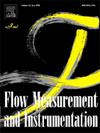Fractal feature map construction and validation for the gas-solid two-phase flow
IF 2.7
3区 工程技术
Q2 ENGINEERING, MECHANICAL
引用次数: 0
Abstract
Feature maps have shown significant potential in gas-solid two-phase flow research. However, traditional feature maps, such as chaotic attractors and recurrence plots, suffer from issues like dependence on subjective parameter selection or structural folding. This study proposes a novel method for constructing a fractal feature map of the gas-solid two-phase flow that effectively captures its fractal properties. Using phase space reconstruction, the electrostatic signal is transformed into a phase space trajectory, and then an inter-point distance matrix is calculated to generate the map. This map exhibits a unique texture structure composed of horizontal and vertical stripes, with a construction process that is nearly independent of parameter selection and free from structural folding. To validate the effectiveness of the fractal feature map, this study simultaneously employs detrended fluctuation analysis (DFA) to examine from a time perspective, and a new method based on the power-law relationship between periodic intensity and spatial scale to examine from a spatial perspective. Results show that the power-law curves obtained from both methods exhibit consistent trends, revealing the fractal properties of gas-solid two-phase flow and confirming the effectiveness of the fractal feature map in capturing such dynamics. This map provides a new tool for flow feature visualization, offering a new perspective for analyzing the behavior of gas-solid two-phase flow, and provides a reference for future exploration of combining deep learning techniques with fractal feature maps to enhance flow pattern recognition and prediction capabilities.
气固两相流分形特征图的构建与验证
特征图在气固两相流研究中显示出巨大的潜力。然而,传统的特征映射,如混沌吸引子和递归图,存在依赖于主观参数选择或结构折叠等问题。本研究提出了一种构建气固两相流分形特征图的新方法,有效地捕捉了气固两相流的分形特性。采用相空间重构的方法,将静电信号转化为相空间轨迹,然后计算点间距离矩阵生成相空间轨迹图。该地图呈现出一种独特的由水平和垂直条纹组成的纹理结构,其构建过程几乎不依赖于参数的选择,也不受结构折叠的影响。为了验证分形特征映射的有效性,本研究同时采用去趋势波动分析(DFA)进行时间视角的检验,并基于周期强度与空间尺度的幂律关系进行空间视角的检验。结果表明,两种方法得到的幂律曲线呈现一致的趋势,揭示了气固两相流的分形特性,证实了分形特征图在捕捉气固两相流动力学方面的有效性。该图为流动特征可视化提供了新的工具,为分析气固两相流动行为提供了新的视角,为今后探索将深度学习技术与分形特征图相结合,增强流动模式识别和预测能力提供了参考。
本文章由计算机程序翻译,如有差异,请以英文原文为准。
求助全文
约1分钟内获得全文
求助全文
来源期刊

Flow Measurement and Instrumentation
工程技术-工程:机械
CiteScore
4.30
自引率
13.60%
发文量
123
审稿时长
6 months
期刊介绍:
Flow Measurement and Instrumentation is dedicated to disseminating the latest research results on all aspects of flow measurement, in both closed conduits and open channels. The design of flow measurement systems involves a wide variety of multidisciplinary activities including modelling the flow sensor, the fluid flow and the sensor/fluid interactions through the use of computation techniques; the development of advanced transducer systems and their associated signal processing and the laboratory and field assessment of the overall system under ideal and disturbed conditions.
FMI is the essential forum for critical information exchange, and contributions are particularly encouraged in the following areas of interest:
Modelling: the application of mathematical and computational modelling to the interaction of fluid dynamics with flowmeters, including flowmeter behaviour, improved flowmeter design and installation problems. Application of CAD/CAE techniques to flowmeter modelling are eligible.
Design and development: the detailed design of the flowmeter head and/or signal processing aspects of novel flowmeters. Emphasis is given to papers identifying new sensor configurations, multisensor flow measurement systems, non-intrusive flow metering techniques and the application of microelectronic techniques in smart or intelligent systems.
Calibration techniques: including descriptions of new or existing calibration facilities and techniques, calibration data from different flowmeter types, and calibration intercomparison data from different laboratories.
Installation effect data: dealing with the effects of non-ideal flow conditions on flowmeters. Papers combining a theoretical understanding of flowmeter behaviour with experimental work are particularly welcome.
 求助内容:
求助内容: 应助结果提醒方式:
应助结果提醒方式:


